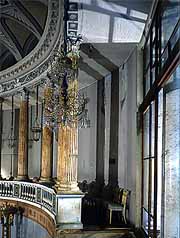 House- Museum 'Ostankino' is a unique monument of Russian architecture of the XVIII century, which is located in the northern part of Moscow. House- Museum 'Ostankino' is a unique monument of Russian architecture of the XVIII century, which is located in the northern part of Moscow.
Once situated in the suburbs of Moscow, this estate now is only 20 minutes drive from the Kremlin and attracts visitors from the entire world.
The ensemble of the museum had developed during several centuries. The first information about Ostankino dates from the middle of XVI century.
The oldest of the monuments is the Trinity Church of the end of the XVII century with nine tiers of the carved iconostasis.Two bottom tiers date from the time of construction of the church, the others - from the end of the XVIII century.
The five-domed temple is built with the red bricks and trimmed with white carved stone and tiles.
The church was build by Princes Cherkassky, that owned Ostankino from the first quarter of the XVI century till the middle of the XVIII century.
When Ostankino was a possession of the Cherkassky family, it was a rich prince's residence with a beautiful temple, the big mansion and an extensive garden.
The estate was at that time so good and well equipped, that the Empress Elizabeth Petrovna visited this place four times.
The Count Nikolay Petrovich Sheremetev, who was one of the richest and notable men of his time, constructed the present Ostankinsky palace.
The famous Russian architects F.Kamporezi, I.Starov and V.Brenna worked on the project of this unusual palace. The count's serf arc hitects A.Mironov and P.Argunov supervised the construction of the palace. Construction had lasted for 7 years (1792 - 1798). The palace is entirely built of wood, but the plastered walls looks like made of stone. hitects A.Mironov and P.Argunov supervised the construction of the palace. Construction had lasted for 7 years (1792 - 1798). The palace is entirely built of wood, but the plastered walls looks like made of stone.
Theatre in Ostankino
The Sheremetev's decision to build theatre turned the destiny of Ostankino. Having perfectly prepared troupe with extensive repertoire and some theatrical premises, Sheremetev planned to have the unique summer pleasure residence.
In the spirit of the Age of Enlightenment, the Ostankino was to become the Pantheon of arts, palace in which the theatre reigns.
In the centre of the palace there is a theatre. Left hallway ushers visitors into the lower foyer - the foyer of orchestra. The foyer occupies the western wing of the palace, the most part of which occupied by the Italian pavilion.
Through the Right hallway visitors enter the top foyer. At the end of foyer there is Picture gallery.
Today the Ostankino is the only Russian theatre of the XVIII century, which has original stage, auditorium and make-up rooms and a part of mechanisms of engine room. Magnificent acoustic properties of this theatre make it the best hall of Moscow by acoustics.Even today the theatre is used to stage the ancient operas and chamber concerts. There are not equally conserved halls with rich carved decor and gilded furniture of the XVIII century as we have in Ostankino.The priceless collections of lighting equipment, sculptures and furniture are placed on the initial places. as we have in Ostankino.The priceless collections of lighting equipment, sculptures and furniture are placed on the initial places.
Collections of the museum.
The museum has various collections. Some of them belonged to the Count Sheremetev, the owner of Ostankino, and some were collected after 1918 when the palace was nationalized and transformed into museum.The collections of the original Ostankino furniture have a special value.
Largest of them is the collection of Russian and West-European gilded furniture of the XVIII- XIX centuries. The museum also has an interesting collection of Russian portrait of the XVIII-XIX centuries, which has works of the Argunov, D.Levitsky and rare works of little-known artists Gorbunov and Parmenov etc.
The collection of drawings and miniatures of the XVIII-XIX centuries has works of the best Russian and foreign artists.
The marble copies of the antique originals represent the palace sculptures.
At the end of the XVIII century in the palace there were thirty antique originals. Only five of them have been preserved to the present days.
|













 Pearls of Russia
Pearls of Russia  Museums and memorial estates
Museums and memorial estates